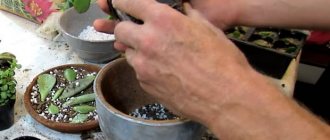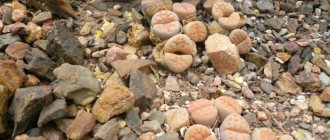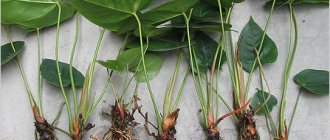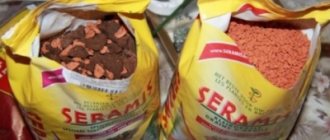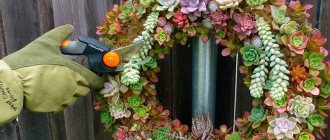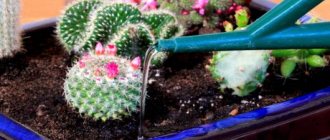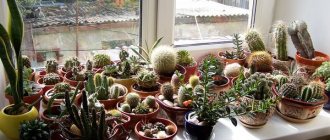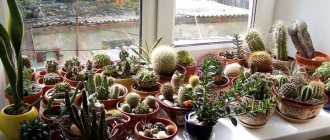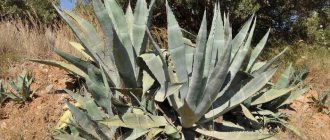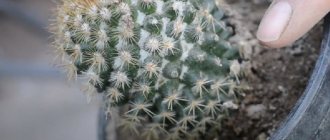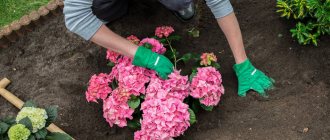Soil selection criteria
Many novice gardeners buy succulents at the store without knowing how to grow them. After purchasing, it is important to know not only how to replant a purchased succulent at home, but also what soil to use for this.
Succulents
To grow succulents, you should choose loose soil that allows air and water to pass through well. Succulents grow both in soil with neutral acidity and in acidic soil. The soil should not contain a lot of nitrogenous fertilizers; it should contain enough mineral components.
What kind of land is needed for planting succulents can be determined by the requirements determined by the preferences of the plants:
- It should be light and loose. Water should pass through it quickly.
- The soil particles must provide air flow to the roots.
- The top layer should dry quickly.
When buying soil in a store, you need to pay attention to its composition. Depending on the type of succulents for planting, soil requirements differ.
The bulk of purchased soil is peat. Most often, two types of it are mixed: upland and lowland. Peat has high acidity, so dolomite flour is added to the soil to reduce it.
Soil in natural habitat
The soil for succulents in the wild is not rich in composition. The homeland of plants is arid places with little rainfall, poor soil, sand, stones, lack of nitrogen in the soil, and its poor composition.
Such conditions of existence in the natural environment have led to the fact that succulents have adapted to harsh circumstances. Their roots quickly absorb maximum moisture, and the above-ground part retains it for as long as possible - for weeks.
Taking into account the conditions that are natural for succulents, you cannot use ordinary universal soil mixtures for growing them.
DIY soil for succulents
Gatsania flower - how it blooms on a club, what soil is needed for growing
You can prepare the soil for growing succulents in pots with your own hands from ordinary universal purchased soil. To make it lighter, coarse sand, ceramic fragments and expanded clay should be added to it. To increase the acidity of the soil, peat is added to it.
Soil for succulents
Experienced flower growers recommend both buying a ready-made mixture for growing succulents and preparing the soil yourself. The main thing is to use the right ingredients and maintain their proportions.
Required Components
The soil for succulents can be prepared entirely with your own hands. The main components of soil for cacti and succulents are:
- leaf soil,
- turf land,
- sand,
- pebbles or crumbs of red bricks.
You can use gravel as soil for succulents. Depending on the size of the flowerpot, 3 types of pebbles are used:
- fraction 1-5 mm;
- fraction 5-10 mm;
- fraction 10-30 mm.
Interesting. Barsik non-clumping cat litter can be used as soil for succulents. It consists of a fine fraction of zeolite. It should be added to gravel in a ratio of 1 to 10.
Substrate proportion
Depending on the root system of the plant, the proportions of the constituent components also change. If the root system is represented by superficial roots, then it is necessary to achieve increased lightness from the soil. The main components are mixed in the following proportions:
- 1 measuring cup of leaf soil;
- 1 measuring cup turf soil;
- 1 measuring cup of sand;
- ½ cup of sand or crumbs.
For plants with well-developed, fleshy roots capable of storing water, the ratios will be different. You only need 3 components: 1 part sand and leaf soil, 1.5 parts turf soil.
Important! When preparing to replant any type of cactus or succulent in a pot, you need to make a thick drainage layer. This will protect the roots from rotting.
When planting plants in a pot, you need to lay 3 layers:
- Drainage. Must be at least 1 cm.
- The main layer is made from purchased soil or homemade soil. This soil layer should not reach the top of the pot by 2 cm.
- Top layer of drainage. Pebbles, brick chips or expanded clay are used for it.
Layer arrangement in a flowerpot
Important! Before watering, the top layer is removed. It must always be dry.
Ready soil for succulents
When purchasing ready-made soil intended for succulents, you should especially carefully study its composition. After all, this group includes quite a few plant species - with different preferences and requirements for soil conditions. And manufacturers’ soil composition may also differ. A mandatory component of most store-bought substrates is peat. It has high acidity, which is usually reduced by adding ground limestone or dolomite flour.
The peat itself is also different:
Horseweed is light, practically does not contain any nutrients, it is bad in that it retains moisture for a long time, and after drying it is very difficult to wet.
Lowland is heavy and cakes quickly. Therefore, leavening agents of natural and artificial origin are added to peat and peat mixtures, most often sand and crushed expanded clay.
There are also special nutritious soils on sale that contain suitable fertilizers. For example, ready-made soils for succulents from Seliger-Agro and Biagro (Bikey LLC). The main component of the substrates from these manufacturers is a mixture of high-moor and low-lying peat. The composition of the soil under the Bereginya brand (Fasco LLC) has added compost to high-moor peat. offers ready-made soil for growing cacti, which includes vermicompost.
Options for growing succulents
Fans of desert plants often want to breed new species. But it is rare that you can purchase a cutting or part of a plant for propagation. Therefore, lovers of exotic plants are faced with the question: “How to plant succulents?”
Vegetative propagation
Cymbidium orchid: options for growing and caring at home
You can grow succulents either from seeds or plant parts. Many types of succulents produce daughter plants on stems. This most often occurs in cacti. You can remove such a plant from the mother plant only after it is fully formed. The signal for this is the gradual detachment of the bottom of the new plant from the mother’s stem.
Other types of succulents are propagated from cuttings or leaves. These parts of the plant can be planted almost immediately into succulent soil.
Important! It is not advisable to root cuttings and leaves in water. This can lead to their rotting.
Many plants in hot and dry countries shed their leaves to reproduce. One such species is Crassula. If a fallen leaf is left on the soil, after a few weeks it will take root and a new plant will begin to develop.
It is better to plant succulents from cuttings in the spring. At this time, they take root well and will get stronger over the summer.
From seeds
Exotic species can only be grown from seeds. You can buy them either in a regular flower shop or order them from an online store.
You can grow succulents from seeds either by following the recommendations of gardeners or by taking into account some of the peculiarities of the propagation of cacti and succulents.
You can germinate seeds using a special container with a transparent lid. You can buy such a container in a store.
Important! There should be small boxes inside the container for planting. Be sure to make drainage holes in the bottom of the pots.
It is best to germinate succulent seeds in a mineral base: a mixture of gravel, sand and perlite. Seeds of plants such as aloe or gasteria are best sown in perlite.
After distributing the substrate among the pots, take a thick sheet of paper and fold it in half. Seeds are poured into the resulting fold and, lightly tapping the folds, they are evenly distributed over the surface of the soil.
When all the seeds are distributed over the surface, they are sprinkled with a layer of sand no more than 2 mm. In this way, you can plant succulents with both large and small seeds.
Important! The covering layer should not exceed the size of the seeds. Very small seeds are not sprinkled at all.
The crops are watered with settled water at room temperature. In order not to wash away the seeds, they need to be watered by spraying from a spray bottle. After watering, cover the container with a transparent lid or film.
The greenhouse begins to be removed after the emergence of seedlings. The hardening time is gradually increased and the cover is removed after the plants reach a size of 2 cm.
Sprouted seeds
When growing succulents from seeds, be patient. Each species has different germination times. Some seeds germinate in 90 days. All this time the soil must be kept moist.
New seedlings can be planted after the seedlings have become stronger and are at least 5 cm in height. Some species require several months for this, while others take a year.
Is it possible to grow succulents in coconut substrate?
Complex topic. The most common answer is that cacti are virtually indifferent to soil as long as they are watered properly.
Coconut shavings are no exception and can be used to grow cacti. An example of this is the “Dutch” technique.
This is a typical type of hydroponic culture, where the plants are kept in a neutral environment and watered with a fertilizer solution.
Coconut flakes are a fairly water- and time-resistant substrate.
But sooner or later it will have to be replaced, and this is where the dance of tearing it from its roots begins.
Therefore, in practice, coconut shavings are not the most convenient substrate, at least for cacti.
For which plants is coconut substrate suitable?
For lovers of astrophytums, cacti, aloe and other succulents, coconut substrate will be useful as a loosening additive to the main soil.
Those who grow arrowroot plants can only use it to fill pots. Many tender plants will root in coir substrate.
Coconut flakes are ideal for almost all moisture-loving flowers native to the tropics.
What are the disadvantages of coconut shells?
On forums dedicated to growing succulents, the attitude of gardeners towards coconut shavings is ambiguous.
You can often find complaints about the quality of coconut shavings (soil containing coconut often develops fungal cultures that suppress the development of succulents).
Coconut potting soil breaks down over time and plant development (especially the root system) is slower compared to plants planted in a clay substrate.
Whether to use this type of substrate or not is a controversial decision.
Home care
Mimosa flower: growing conditions and plant care options
When growing succulents, you should distinguish between winter and summer care. In the warm season, plants should be watered no more than twice a week. At this time, the plant is actively growing, so regular feeding is needed. In winter, watering is reduced to twice a month, and fertilizing should be stopped completely.
Important! Succulents and cacti cannot grow well without sunlight. They are not afraid of direct sunlight, so they can be safely placed on the windowsill.
In winter, for more light, it is better to place pots with succulents close to the glass. This will help lower the temperature by 2-3 C and increase the lighting of the plant.
Succulents can be replanted in both spring and summer. Inspecting the succulents will help determine the need for replanting. The following signs will indicate the need for this procedure:
- A gap has formed between the pot and the soil.
- Roots emerged from the drainage holes.
- The size of the plant exceeds the volume of the flowerpot.
Both professionals and beginners can replant succulents at home. The transplant must be carried out following the following steps:
- To transplant succulents and cacti, prepare a pot, soil, drainage and hand protection. In addition to gloves, it can be foam or thick cardboard.
- About a week before transplanting, stop watering the plant.
- If the succulent is healthy, then it can be transplanted using the transshipment method. If it is necessary to inspect the roots, carefully remove the dried soil.
- The plant is placed in a new pot and covered with substrate. After watering, the top layer is covered with pebbles or expanded clay.
To provide exotic species of succulents with an optimal microclimate, they can be planted in special florariums. These are special glass or transparent plastic vessels with a narrow neck. Often it is closed with a stopper. Quite often they are equipped with a heating and lighting system.
Florarium
When creating a succulent composition, you need to choose plants from the same area. They should have similar watering regimes and lighting needs. If you do not take this rule into account, the plants will quickly die.
The right approach and adherence to the rules of care will help you grow not only familiar plants at home, but also surprise your guests with plants from other countries. By combining succulents of different shapes and colors, you can create a beautiful composition that will decorate your home.
Planting and transplantation technology
It is recommended that all soil mixtures, whether purchased in a store or made independently, be thoroughly calcined in the oven or steamed. It is usually steamed as follows: wet sand is placed on the bottom of the dish, and the remaining components are placed on the second “tier”. The hot steam rising from the sand will fulfill the main mission of disinfecting the soil for succulents. Since after such a procedure all microorganisms die, 2–3 weeks after transplantation into such soil it is necessary to treat with special biological preparations.
When planting succulents, it is important to pay attention to the size of the container. Most of them do well in cramped containers. When replanting, it is recommended to increase its diameter each time by only 1.5–2 cm. Young plants are replanted every year, adults and large ones – every 2–3 years. For fast-growing specimens, it is recommended to change the pot using the transfer method.
The best time for replanting is early spring, when the plants emerge from winter dormancy. There must be a drainage layer of sand or expanded clay at the bottom of the pot; the planting soil on top can also be sprinkled with expanded clay or pebbles - this will prevent rotting of the root collar. In order for the disturbed root system to recover, it is not recommended to water the plants in the first few days after transplantation. And before transplanting - at least a week - watering should be limited or stopped altogether.
Similar articles:
- Soil for cacti
- How to grow a rose from a bouquet
- Travyanchik
- Soil for orchids
- Plants for florarium
- Florarium
Soil for cacti: we don’t buy it, we make it ourselves
Store-bought soil is not suitable for cacti and succulents. Succulents grow in the desert
, where the soil is dry dust, clay, stones and sand. Look at the photo in the article on the native habitats of cacti: we need to repeat this at home. And don’t try to give them “more nutritious” soil, as you will only ruin the plants.
Store-bought mixtures, even special ones for succulents, are all based on peat. completely unsuitable for these plants.
. Even “Soil for desert cacti” is still based on peat.
Cacti will collect moisture immediately, store it in their bodies, and excess water must be evaporated or drained to prevent fungal diseases and rot. It's actually cheaper (and better for plants) to make your own mixture
.
Caring for Succulents
Pot
The pot should be such that water does not collect around the roots of the plant.
From excess moisture, the roots of the plant will begin to rot and the entire plant will hurt.
Pots should have drainage holes to ensure good air flow allowing the soil to dry out easily.
The best pot for these plants is a clay pot that is not glazed.
If you have a plastic pot, you will need to make additional holes in the sides or bottom to remove excess moisture.
Temperature
Most of the time, the temperature in our homes is suitable for growing succulents.
They tolerate the heat of summer and the freshness of winter well.
In winter they are able to tolerate temperatures from 5 to 10 °C.
For some succulents, cold temperatures stimulate flowering, which occurs in the spring or summer.
Irrigation
Excessive irrigation for these plants can be disastrous and this is one of the most common mistakes made when maintaining them.
When watering, you should not wet the leaves; you should water the substrate, and you should water it when the soil is already dry.
If you want to wipe the plant, you can spray the leaves with water, but they must be wiped immediately with a cloth.
This plant really likes it when its roots are watered.
In winter, it is recommended to water them once every 14 days.
In summer, one watering every 7 days will be sufficient.
These plants are able to absorb moisture from the environment and retain it in their leaves, stems and roots.
Using this ability, succulents can be used in an original way to decorate the interior, for example, suspended in the air with virtually no substrate.
Light
Succulents need a lot of light, at least 6 hours, but they should not be placed in direct sunlight, especially in the summer, because they need to retain water reserves for as long as possible, and dehydration will begin to occur in the sun.
If the leaves begin to turn red and brown, this means that the plant is suffering from excessive sun and is beginning to dry out.
If the leaves turn pale, this means that the process of photosynthesis is not occurring and the plant needs more light.
Another sign that they don’t have enough light is that the leaves begin to stretch and reach towards the sun.
During the warm season, it is very useful to take plants outside, this will help them be healthier.
Soil and drainage
This type of plant grows on trees and rocky areas, so there is no need to use soil rich in minerals.
The substrate is best brought to the natural conditions in which this plant grows, which is desert and semi-arid areas.
Succulents need good drainage to prevent waterlogging due to excessive water, gravel can be used as drainage.
If a succulent is placed in a waterlogged environment, parts of the plant will become soft and eventually die.
Do not place a saucer under the pot so that the plant does not absorb excess water, and if you do, drain the water from it so that it does not stagnate.
You can prepare the substrate yourself, here are two recipes:
- 1 part soil, 1 part sand and 1 part moss.
- Mix equal parts of universal substrate and sand.
The soil in which the plants will be located should not contain roots from other plants and should be loose.
Transfer
Succulents are replanted to stimulate their growth, to refresh the substrate, and to cut off dead and rotten roots.
When replanting, it is advisable to take a pot a little larger than the previous one so that the plant can grow.
It is important that there are holes at the bottom so that water can drain. It is advisable to use terracotta pots, which are porous and do not retain moisture
It is advisable to use terracotta pots, which are porous and do not retain moisture.
Pests and diseases
Root rot and stem rot, caused by various fungi, are the most common diseases.
To prevent them, make sure the soil is dry and well ventilated.
If the plant is kept in good conditions, then pests are unlikely to bother it.
If the soil is too wet, mosquitoes will begin to gather near this plant.
So to prevent mosquitoes from harming your succulent, simply keep the soil dry and provide good drainage.
Another pest is the cotton mealy bug.
To get rid of this insect, apply alcohol to the plant, but at the same time, the plant should not be in direct sunlight.
How to care for succulents in winter
Succulents are very heat-loving plants and they do not tolerate cold air and frost.
Therefore, during the winter months they should be kept out of drafts and placed where they receive plenty of natural light through a window.
Characteristics and use of hydrogel
Relatively recently, hydrogel appeared in floriculture stores. This product immediately attracted the attention of buyers due to its amazing appearance. The product may be sold in the form of granules, powder or crystals. It is able to absorb and retain moisture. When wet, the elements increase significantly in size. Manufacturers have added safe dyes to their composition, thanks to which the granules are full of a variety of colors.
Larger hydrogels are used as a substitute for substrates and soils for houseplants. Plants are planted in transparent containers, creating amazing living compositions. The fine product is mixed with soil. This composition is often used for germinating seeds.
Often the product acts as a decorative addition to the interior. By mixing several bright colors in one transparent container, you can add color and expressiveness to your decor. Such an element will become an accent and complement the style.
vote
Article rating
Interior use
Most people who want to see growing greenery at home without spending extra time and effort, purchase literally one or two small succulents in separate small pots that decorate the room, rather symbolically - an inattentive person may not notice such an interior detail.
At the same time, there is an opposite approach: the so-called “cactus growers” are able to fill their apartment with succulents so densely that the installation of them automatically becomes the central element of the home’s interior. Some examples show that these indoor plants can create real works of art.
Succulents as a material for creativity are good for the reason that, despite their general similarity to each other, they are still capable of differing in size, shape, and shades. Their owner may be extremely far from creating full-fledged paintings or complex compositions, but the geometric correctness of the arrangement of individual pots can already create a positive impression. In the photo we see how small differences in the appearance of each row can please the eye.
At the same time, some succulents, even those that are not blooming at a particular moment, look slightly reminiscent of classic flowers. By planting them correctly in a cramped pot so that the soil is not visible, you can create a kind of bouquet that will have a huge advantage over the real thing - it will not wither in a week or a month.
A popular solution is the so-called florarium. In appearance, it somewhat resembles an aquarium or terrarium, since in fact it is a transparent pot, in which the soil level does not even reach half, and the plants themselves remain entirely inside, without protruding out. The task of a person creating a composition for a florarium is to try to create a “patch of natural nature,” although in fact the species he has chosen may not even grow on the same continent.
In most cases, a florarium still imitates an abundance of greenery, but the association with the south does not necessarily mean dense thickets. All these cacti and agaves often grow in desert areas, where there is practically nothing but them - only sand, but this still reminds of a hot summer and creates a unique flavor of the south. You can convey a typical desert picture using the same succulents, carefully selected and planted on clean sand with the addition of shells to enhance the impression. If you still doubt that it can look attractive, take a look at the composition in the photo.
As a rule, green collections occupy horizontal areas in the room, but some “cactus growers” prefer to collect entire wall panels. It should be noted that this task is quite difficult, since succulents occupy a central position in it, but are not the only detail - at a minimum, you also need to spend money on some shelves and flowerpots that will hold the greenery in weight, or try to make them yourself.
By building a structure similar to the one shown in the example below, you will almost certainly achieve 100% uniqueness of the interior of your home, which today is considered an indicator of good taste. It will be doubly pleasant also because this is not a thing made by someone else’s hands, bought for a lot of money, but a personal creation.
In the photo of the panel it is noticeable that it is divided into several fragments - this is necessary at least in order to keep the soil in a vertical position. If you use this approach, then each individual frame can be an independent decoration for the room, as if creating a picture. Of course, it will be difficult to assemble a well-recognized image from succulents, because most likely you will have to limit yourself to abstract subjects, but the brightness of the shades will be even better than if you used the brightest colors, since such a picture will have a very natural three-dimensional effect.
For the best succulents for beginners, watch the following video.
Preparatory work
Selecting a container for sowing
The unpretentiousness of succulents can be seen even in where the seeds are planted for germination. These plants do not need special pots made of heat-resistant materials. For proper cultivation, you will need plastic containers that are not too deep (the height of the side is approximately 5 cm). Holes are needed at the bottom for excess moisture so that the seeds do not rot. If the manufacturer does not provide them, make the holes yourself. The hole diameter should be from 3 to 5 mm.
Since succulents are exotic plants that love warmth, the container should be covered with a transparent lid on top to create a humid and hot atmosphere inside. In extreme cases, you can use plastic film.
You can also plant succulents in ready-made mini-greenhouses, which are sold in special stores, including those imported from China.
Soil selection and preparation
Equally important in propagation is the soil in which the seeds will germinate. There is no need to order soil for succulents from abroad
Ready-made mixtures are sold in stores; you just need to pay attention to a few nuances:
- Succulents grow in difficult conditions, so in order for the plant to quickly adapt to the new environment, it is better to use coarse soil, such as a mixture of soil with sand or fine gravel. Some gardeners recommend adding crushed coal to this composition.
- Be sure to take a ready-made substrate for planting plants. The soil and sand from under the entrance are not suitable for propagating succulents. In special stores, the soil is not just poured into bags, it is also treated and disinfected beforehand.
- If there is no special store nearby, then you can purchase regular peat filler and add sand and other minerals to it yourself.
Seed preparation
Preparing for sowing is the most difficult and painstaking stage of propagating succulents. The small seeds are very similar to each other, so it is easy to confuse them, and different types of plants require different soil and frequency of watering.
Preparation for germination begins with selection. You need to spread the seeds on a white sheet of paper and select the dried or rotten ones. Afterwards, all the seeds are divided into groups and tags are created for them, which will be attached to the pot after sowing.
It is strictly forbidden to disinfect seeds. This will kill the protective layer.
